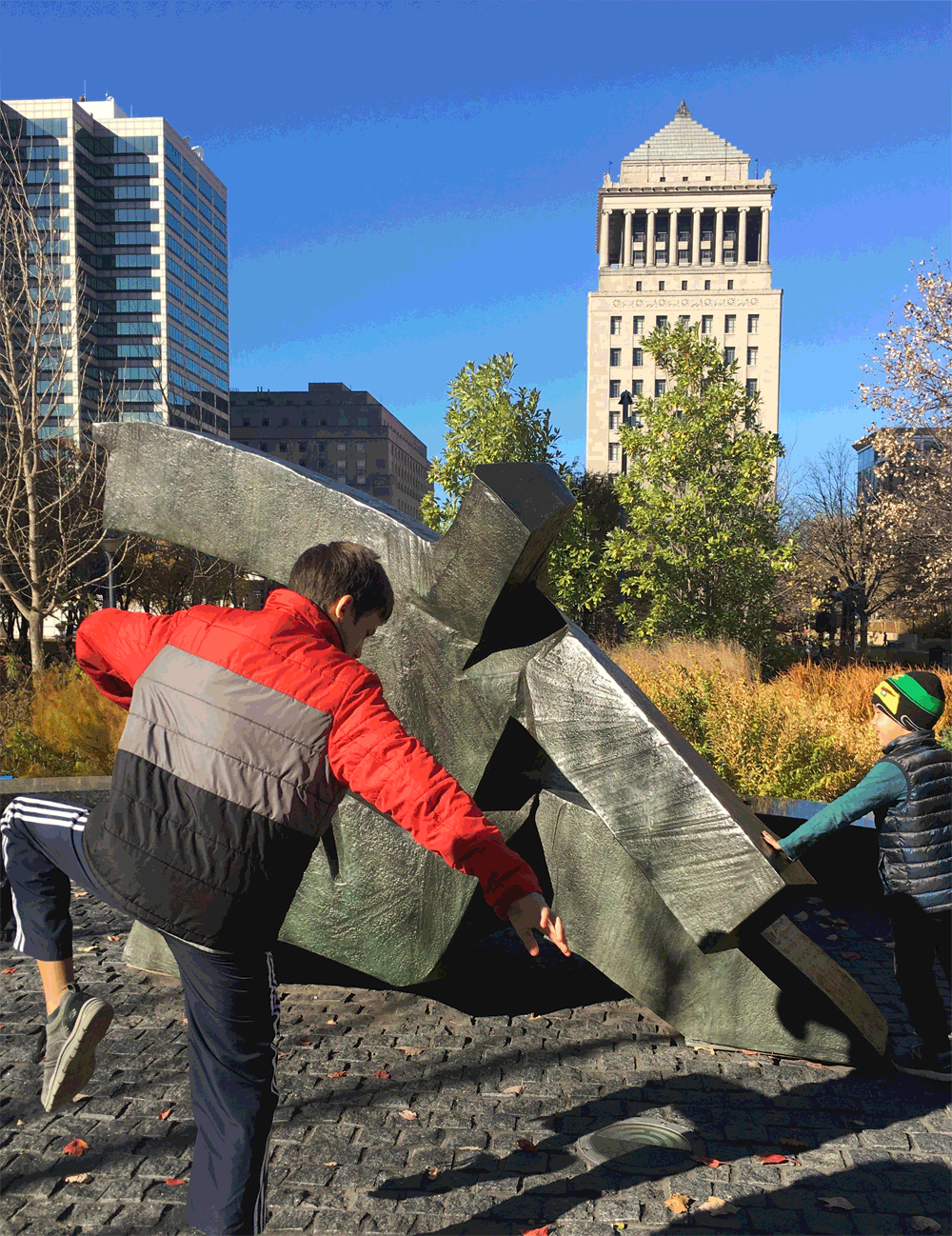





We practiced our ninja poses, danced in the grass like no one was watching, and tried to see how many kids could fit in a giant head. That pretty much describes our life any day, but I’m pretty excited that it was at an art collection on this day! We visited the Citygarden in St. Louis last fall. We could have chosen to casually walk the paths observing the plants, the sunshine, and the sculptures. Both are fine options, but art actually looks different when you climb it, hide under it, or dance around it.
Citygarden is a curated collection of 24 sculptures. The artworks vary in media and intent, but are generally heavy, sturdy, and permanent. “Big White Gloves, Big Four Wheels” by Jim Dine was actually commissioned for the site. If you want to learn more about the artwork, they have an audio guide, app, and brochures on site. “Please Touch” is the title of the recently (2016) published art catalog (which you can order on Amazon) on Citygarden. There are not many art collections where visitors are allowed to touch the art. So, if you get the chance to go to St. Louis, lean on that sculpture. Or better, follow the lead of any kid trying to figure out if this is a good place to play or good place to experience art.
This is an easy place to enjoy art with kids. Only 2 blocks long, Citygarden is in downtown St. Louis near the ball park and the arch. If you have small children, note that the park is not fenced and is bordered by large roads.


One block west of the Citygarden is a second sculpture park! “Twain,” a sculpture by Richard Serra, was installed over two decades before the Citygarden was created. When Serra’s artwork was commissioned in 1974, it was controversial. In the block adjacent to Citygarden, there are seven 40-foot long steel walls making a sort of triangle. The only sign that you have left the Citygarden is that the landscaping changes. There are no overflowing flowerbeds, paths, or signs in the “Serra Sculpture Park.”
Inside Richard Serra’s sculpture is lost space. Although the work is larger than any other we saw that morning, it did not seem as significant. Most of Serra’s work leads with stature and resists immateriality. However, I am captivated by the moments when the work or the site subverts the dominance of his materials. Although, my favorite experience of his work was when I was playing hide and seek with my children inside his sculptures at Dia:Beacon. It was the first time I observed how gracefully and profoundly the form circulated light. Similar to how the land engulfs his sculpture at Storm King, the site and the upkeep of “Twain” make it feel less monumental.
When you squeeze between any of the large steel sheets, you enter a space that feels useless and hollow. It’s not easy to recognize because it is similar to feeling bored. Remarkably, you suddenly find distance and experience emptiness in the center of the city through a very simple form. When you move between the outside and inside of the sculpture, there is a shift in how you perceive the environment. And there is an opportunity to pause and ask yourself what a void means here or in any context. The power of art is in it’s ability to create pause or change without telling me to do so. “Life” has it’s own voids and it’s own tools to make me change. I tend to like art’s better, but I also see art as making me ready for life.


The Citygarden and Serra Sculpture Park are located near tourists stops, food trucks, and playgrounds. My children may argue that a good playground and a good art museum are difficult to differentiate. The new playground at Kiener Plaza is just one block east of Citygarden. The log climbing structure is challenging and fun for all ages. Don’t miss this chance to easily introduce your children to a few notable artists like Richard Serra, Julian Opie, Jim Dine, Keith Haring, Tom Claassen, Erwin Wurm, Tom Otterness, etc. These are names that you will come across in other art museums. The pro here is that it is free and outside.